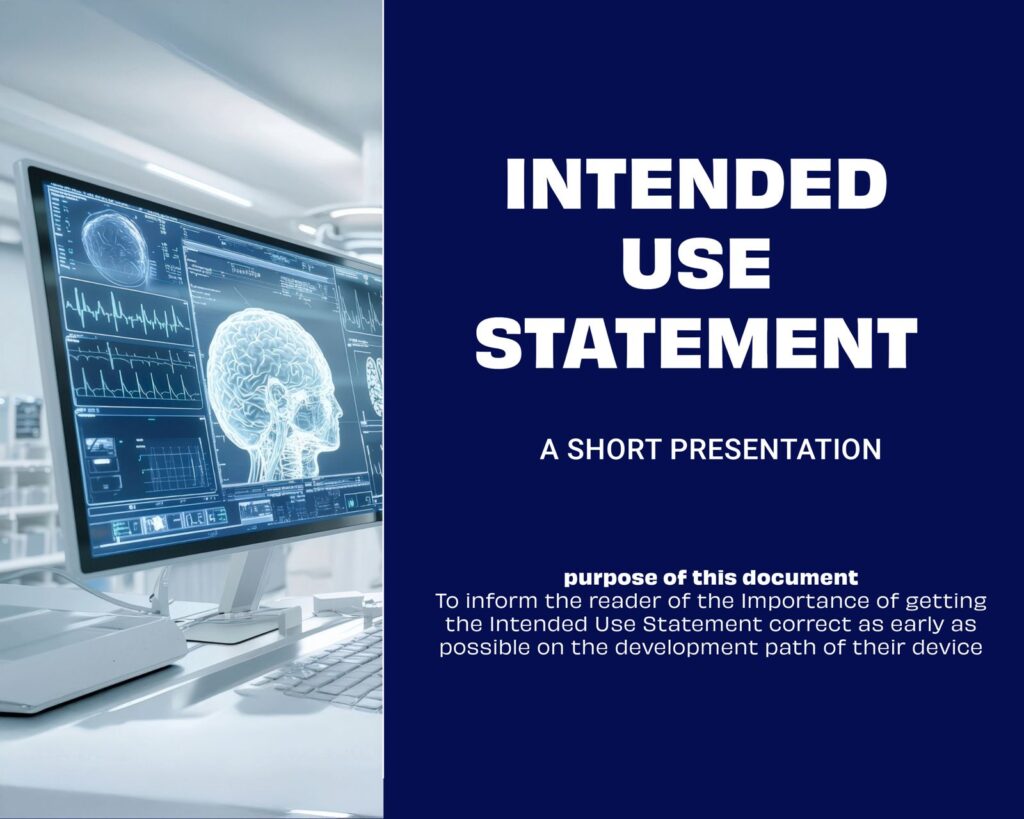Intended Use Statement
An intended use statement in medical device development is a clear, concise description of what the device is meant to do, who it is for, how it will be used, and under what conditions. It sets the foundation for everything that follows in the device’s development, regulatory approval, and market success.
It typically includes:
- Target patient population (e.g., adults with Type 2 diabetes)
- The medical condition or disease it addresses
- Clinical setting (e.g., home use, hospital ICU)
- User (e.g., healthcare professionals, patients)
- Mode of action/use (e.g., delivers insulin via subcutaneous injection)
- Intended outcomes (e.g., improved glucose control)
Regulatory Classification
- Regulatory bodies like the FDA or EU MDR use the intended use to classify the device, which determines how rigorous the approval process will be.
- It affects whether the device is Class I, II, or III (in the U.S.), or falls under MDR Class I, IIa, IIb, or III (in the EU).
Design Input Definition
- It drives the design inputs (requirements) that engineers, designers, and developers use to build the device.
Risk Management
- It identifies potential risks and hazards early, based on the context of use, patient population, and operating environment.
Clinical Evaluation & Evidence
- It defines what clinical data you’ll need to collect to prove the device is safe and effective for its intended use.
Labelling & Instructions
- It guides what goes on the label and in the Instructions for Use (IFU), ensuring compliance and patient safety.
Marketing and Claims
- What you claim in advertising must match the intended use. Making unapproved claims can lead to serious regulatory consequences.
Example:
Let’s say you’re developing a wrist-worn heart monitor.
- Weak intended use: “Monitors heart activity.”
- Strong intended use: “A wearable ECG device intended for adult patients with known arrhythmias to monitor heart rate and rhythm during daily activities at home, with data reviewed remotely by a healthcare provider.”
The second version helps define technical specs, safety needs, and clinical claims, while keeping regulators, developers, and users aligned.
If you’re early in development, crafting a solid intended use statement helps you avoid scope creep, regulatory surprises, and expensive redesigns later. Want help drafting one for a specific device?
Great question — changing the intended use during development is definitely possible, but it comes with serious implications across technical, regulatory, and business areas.
1. Regulatory Impact
- Reclassification risk: A change might shift the device into a higher-risk class, triggering stricter regulatory requirements (e.g., needing clinical trials or different premarket submissions like a 510(k) vs. PMA in the U.S.).
- New submission needed: If you already submitted to regulators or are close to submission, a significant change will likely require a new or updated submission.
- New clinical evidence: You may need to collect additional clinical data to support the revised claims or use-case.
2. Design & Development Adjustments
- Design inputs/output updates: You’ll need to go back and update your design inputs, which flow down to system requirements, specifications, and testing.
- Verification & validation: All V&V activities must align with the new intended use, so you’ll likely need to repeat or add new testing.
3. Risk Management
- A change in use (e.g., now intended for a more vulnerable patient group or a different clinical setting) requires reassessing all risks under ISO 14971. New hazards may appear, and mitigations might have to be redesigned.
4. Labeling & Instructions
- All labelling, packaging, and user manuals will need to reflect the new intended use, including warnings, contraindications, and instructions.
5. Business & Market Strategy
- A new intended use might mean entering a different market, competing against different products, or needing to redefine your value proposition.
- It could affect reimbursement pathways, pricing, and even your sales model (e.g., direct to consumer vs. hospital procurement).
If your team realises the intended use must evolve:
- Document everything: Use your quality management system (QMS) to formally log the change through a design change control process.
- Assess impact: Re-evaluate all downstream processes — risk, usability, testing, labelling, clinical data.
- Engage early with regulators: Especially with significant changes, talk to the FDA or your Notified Body early to understand what’s needed.
- Update stakeholders: Communicate the change to your internal teams – engineering, regulatory, clinical, and marketing – to stay aligned.
Changing the intended use isn’t the end of the world, but it is a reset button in many ways. The earlier you can detect the need for a change, the less painful (and expensive) it is.
Want to walk through an example or explore how this might affect a specific kind of device?
To understand what is a significant change, you must define this in your QMS. The following MDCG guidance document will help you see the flowcharts within the document:

